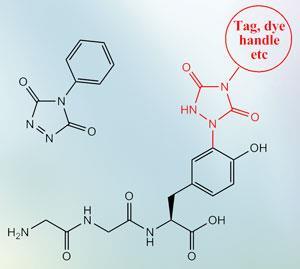A cyclic diazo compound can attach to the phenol ring of tyrosine under mild conditions providing a new route to modify proteins
Chemists in the US have discovered a new way to attach small molecules to proteins and peptides under mild, aqueous reaction conditions. The method, which relies on a novel type of ’click chemistry’, involves the reaction of a diazo bond with the phenol of the amino acid tyrosine. The work offers a new approach to ’bioconjugation’ - attaching compounds to biological molecules - which is key in many areas of biological research, including the development of new drugs.
Currently most small molecules are typically attached to proteins via lysine or cysteine residues. However as target amino acids these have limitations; for example lysine is so abundant that it is difficult to select accurately where the molecule attaches on the protein structure. Furthermore, given that biomolecules are relatively fragile, any chemistry carried out to modify proteins must be done under mild conditions. Finding candidate molecules that will react in this way is challenging.
Now, Carlos Barbas and colleagues at the Scripps Research Institute in California have found a new way to link molecules to proteins and peptides through tyrosine.
The team showed that a cyclic diazodicarboxamide could react with a modified tyrosine molecule with the diazo bond ’clicking’ to the phenol of the tyrosine. Click chemistry, a concept developed by Barry Sharpless in 2001, involves the modular assembly of molecules through the reaction of high energy bonds under mild reaction conditions.

Having shown that this new click reaction worked in principle, Barbas and his team then attached the diazo molecule to a range of peptides and proteins via tyrosine residues and showed that the small molecule could carry a range of functional groups. If an azide ’tail’ is carried by the diazo molecule then further conventional click chemistry is possible to attach a wide range of other functionalities through the azide.
Importantly the products are highly stable, says Barbas, and the reactions ’very efficient and should be very useful for a wide range of uses not only in bioconjugation but broadly to modify any phenol-containing molecule.’
Barbas adds, ’It works well with the amazingly successful Sharpless click chemistry that has been applied widely across many disciplines.’
Claude Meares, a bioconjugation expert at the University of California, Davis, says, ’Reaction conditions, yield, and selectivity are particularly important for bioconjugations. The results reported from the Barbas lab are very promising, and there are obvious uses for this chemistry if the selectivity for tyrosine over lysine proves to be applicable to proteins in general.’
Simon Hadlington
References
H Ban, J Gavrilyuk, and C F Barbas III, J. Am. Chem. Soc., 2010, DOI: 10.1021/ja909062q






No comments yet